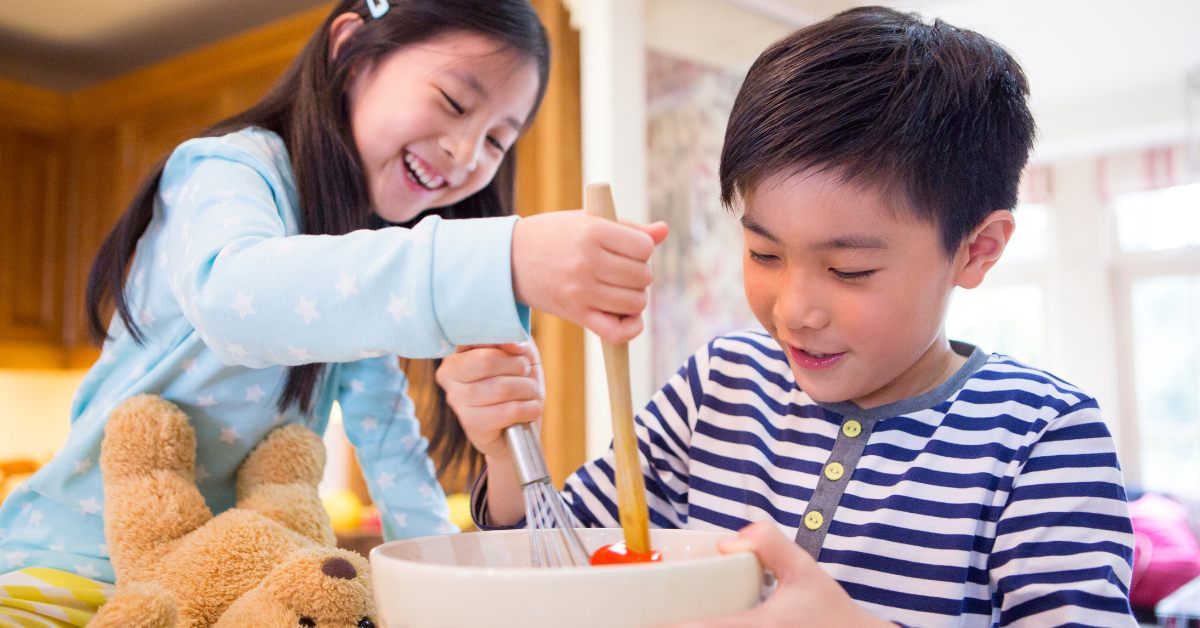I am a huge fan of getting kids involved in food preparation, so they know what goes into the foods they eat, and they get a sense of ownership and pride in preparing food.
I try to get kids interested as early as possible in their food preparation.
At 14 months, my current littlest lady loves to sit in her highchair and watch me make the food she is about to eat. Her sister, a seven-year-old girl with special needs enjoys helping as much as she can. In the coming months, I am going to continue working with her to make simple things she can eat. We will continue to work on making baked goods as her cognitive delays are slowing her understanding. So far, she has helped make cupcakes, cookies and cornbread. Next, we’ll work on meatballs and making chicken nuggets from scratch.
It’s important to get children involved in food preparation so they understand the basics and can learn how food is made. You can start by having them watch how you make things, and then ask if they would like to help. Some kids will jump right in, and others might need a little encouragement to get them started, especially if they are going to get their hands dirty.
When the kids are interested, make sure to teach the basics.
Start with clean hands, hair tied back if necessary and an apron. These are the ultimate basics for anyone who is cooking! When everyone is ready to help, start with simple steps. Kids can easily help with measuring and mixing ingredients, pouring liquids into measuring cups and then pouring ingredients into the mixing bowl. Kids love whisking ingredients together. The possibilities for these tasks are endless!
When basic mechanics are mastered, you can start teaching kids how to follow a recipe. Reading what the ingredients are, identifying those ingredients, and combining them according to the directions are all steps to work on mastering with them. Having ingredients cut, grated, and ready to measure, mix and follow the recipe at this stage makes this easy for younger children to follow the recipe. Teach them about preheating the oven for baking, including checking inside the oven for items that shouldn’t stay in there when the oven is on. Teaching children this simple extra step could save them (and you!) from melted or damaged items in the future!
As kids get older, they can learn how to chop, grate, and peel ingredients.
Make sure they know how to safely use a knife, grater, and peeler. I have had children as young as 4 participating in these functions, depending on the maturity of the child and their ability to understand the importance of safety and dangers of being unsafe when using these utensils. Most children by age 8 are ready to learn the basic functions of chopping, grating and peeling ingredients. When they are at this age, they can begin to understand all the work that goes into food preparation, and they will begin to appreciate their meals more!
Once children have mastered all these steps, you can begin to teach them about safety regarding the use of the oven, stove, microwave and other kitchen appliances. Following strict safety protocols at this point can save you from injuries in the future! Make sure there are a few sets of potholders and oven mitts handy for use and a fire extinguisher at the ready in case of an accidental fire. Teaching basics like cooking a scrambled egg, hard boiling eggs, flipping pancakes, and other basic skills will set the foundation for more advanced techniques in the future!
I hope this is helpful in allowing you to start getting kids involved in the kitchen!
The US Nanny Association thanks all the nannies, advocates and business leaders who provide practical tips and insight to elevate our industry. Thank you for sharing your expertise.

Sara Brenton is a career professional nanny of 20+ years and a classically trained chef, with an A.A.S in Culinary Arts and a B.S. in Food Marketing from Johnson & Wales University. This puts me in a unique position to be able to experiment with food for and with kids! From hiding the good things in the “junk” foods (like shredded zucchini in chocolate muffins, carrot puree in tomato sauce, or butternut squash puree in mac and cheese) to coming up with ways to include kids in their own food preparation, there are ways to get the job done! I hope to share tips, techniques and ideas for you on helping picky eaters broaden their horizons and getting kids as young as two involved in cooking!

